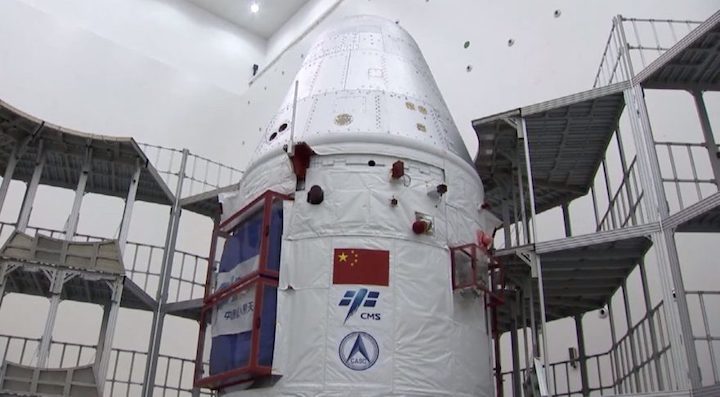24.03.2020

HELSINKI — The test launch of the Long March 5B heavy-lift rocket carrying a Chinese new-generation spacecraft is going ahead despite the coronavirus outbreak.
The prototype new-generation crewed spacecraft payload is designed to be capable of deep space travel, including crewed lunar missions. Measures introduced to contain the COVID-19 outbreak have altered, but not halted, launch preparations.
“To cope with the epidemic outbreak, we have arranged minimum staff members to fulfill the task on the premise of guaranteeing the high work standards,” Yang Qing, chief designer of the new-generation crewed spacecraft of China Academy of Space Technology (CAST), told CCTV.
“All the work we carried out here will be notified and confirmed by other staff by telecommunication so as to ensure the work quality”.
The mission is also proceeding despite the failure last week of the Long March 7A, which shares commonalities with the Long March 5B. This suggests that the cause of the so-far unspecified failure was likely related to the second or third stage. Amateur footage of the launch hinted at an anomaly following first stage separation.
Launch of the Long March 5B is currently scheduled for mid-late April from the coastal Wenchang spaceport.
Chinese new-generation spacecraft
The primary goal of the mission is proving the Long March 5B for launching 20-metric-ton modules of China’s space station to low Earth orbit.
The prototype new-generation spacecraft will carry extra propellant. This will provide a better analogue to the space station modules in terms of mass. It will also allow testing in a higher orbit.
The two-module, 8.8-meter-long, 21.6-ton spacecraft will use its own propulsion to raise its orbit to an apogee of around 8,000 kilometers. The subsequent high-speed reentry will test new heat shielding.
Avionics, performance in orbit, parachute deployment, a cushioned airbag landing, recovery will be tested. Planned partial reusability—by replacing the heat shielding—will also be trialed.
The as-yet-unnamed spacecraft will be capable of carrying up to six astronauts, or three astronauts and 500 kilograms of cargo. The Shenzhou can carry three astronauts to LEO and has been used for all six of the country’s crewed missions.
The Long March 5B launch vehicle includes a five-meter-diameter core stage and four side boosters. The test launch is the first of numerous launches required to construct the planned three-module Chinese space station.
The new launcher was recently rolled out for a wet dress rehearsal. Fit checks with a prototype of the roughly 22.5-metric-ton liftoff mass Tianhe core module were also conducted.
“China has planned about 12 flight missions for the construction of China’s space station. The first flight mission of [the] Long March-5B rocket is also to verify its performance,” Hao Chun, director of the China Manned Space Engineering Office, told state media.
Rocket activities resume at epicenter
Expace, a commercial launch service provider for solid-propellant Kuaizhou rockets, has resumed activities despite its proximity to the epicenter of the outbreak. The firm temporarily halted work in February.
“We combined the original Kuaizhou-11 rocket test team, Kuaizhou-1A rocket test team and the Xingyun satellite test team into one team,” Zhang Di, commander of Kuaizhou joint test team, told CCTV. “By using the ‘cloud scheduling’ online system, we coordinated with each other to complete the testing work.”
Expace is situated in the Wuhan National Space Industry Base, a hub designed to facilitate commercial space activities. The firm is a spinoff from defense contractor CASIC and its subsidiary, China Sanjiang Space Group. The Kuaizhou launch vehicle series are understood to be derived from missile technology.
The company had planned to launch five-to-six times in the first half of 2020, before the coronavirus outbreak. A new Kuaizhou-11 rocket, larger than the Kuaizhou-1A currently in service, was reportedly scheduled for a test flight late February.
The next Kuaizhou-1A mission is expected to launch a pair of Xingyun satellites from Jiuquan. Xingyun is planned to be a 80-satellite narrowband constellation for Internet of Things connectivity.
Quelle: SN

